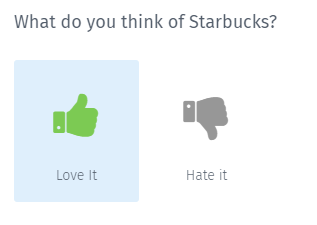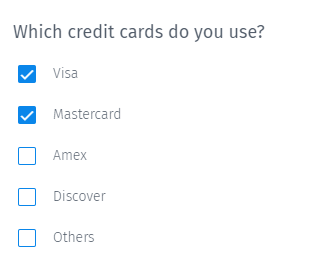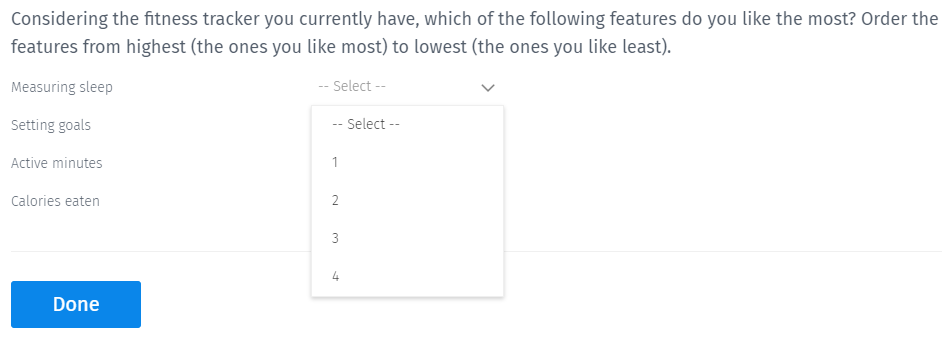
Watch the 1-minute tour
Close ended questions are defined as question types that ask respondents to choose from a distinct set of pre-defined responses, such as
“yes/no” or among set multiple choice questions. In a typical scenario, closed-ended questions are
used to gather quantitative data from respondents.
Closed-ended questions come in a multitude of forms but are defined by their need to have explicit options
for a respondent to select from.
However, one should opt for the most applicable question type on a case-by-case basis, depending on the
objective of the survey. To understand more about the close ended questions, let us first know its types.
Dichotomous Question
These close ended question are indicative questions that can be answered either in one of the two ways,
“yes” or “no” or “true” or “false”.
Multiple choice question
Multiple choice closed ended questions are easy and flexible and helps the researcher obtain data that
is clean and easy to analyse. It typically consists of stem - the question, correct answer, closest
alternative and distractors.

Types of Multiple Choice Questions
1. Likert Scale Multiple Choice Questions
These closed ended questions, typically are 5 pointer or above scale questions where the
respondent is required to complete the questionnaire that needs them to indicate the extent to
which they agree or disagree.
2. Rating Scale Multiple Choice Questions
These close ended survey questions require the respondents to assign a fixed value in response, usually
numeric. The number of scale points depends on what sort of questions a researcher is asking.
3. Checklist type Multiple Choice Questions
This type of closed ended question expects the respondents to make choices from the many options
that have been stated, the respondent can choose one or more options depending on the question
being asked.
4. Rank Order Multiple Choice Question
These closed ended questions come with multiple options from which the respondent can choose
based on their preference from most prefered to least prefered (usually in bullet points).
While answering a survey, it is most likely that you may end up answering only close ended questions. There is a specific
reason to this, close ended question helps gather actionable, quantitative data. Let’s look at the
definitive instances where closed-ended questions are useful.
- To obtain quantitative insights:
Closed Ended Questions have very distinct responses, one can use these responses by allocating a
value to every answer. This makes it easy to compare responses of different individuals which, in
turn, enables statistical analysis of survey findings.
For example: respondents have to rate a product from 1 to 5 (where 1= Horrible, 2=Bad, 3=Average, 4=
Good, and 5=Excellent) an average rating of 2.5 would mean the product is below average.
To restrict the responses:
To reduce doubts, to increase consistency and to understand the outlook of a parameter across the
respondents close ended questions work the best as they have a specific set of responses, that
restricts the respondents and allows the person conducting the survey obtain a more concrete
result.
For example, if you ask open ended question “Tell me about your mobile usage”, you will end up
receiving a lot of unique responses. Instead one can use close ended question (multiple choice),
“How many hours do you use your mobile in a day”, 0-5 hours, 5-10 hours, 10-15 hours. Here you can
easily analyse the data form a conclusion saying, “54% of the respondents use their mobile for 0-5
hours a day.”
To conduct surveys on a large scale:
Close ended questions are often asked to collect facts about respondents. They usually take less time
to answer. Close ended questions work the best when the sample population of the respondents is
large.
For example, if an organization wants to collect information on the gadgets provided to its employees
instead of asking a question like, “What gadgets has the organization provided to you?”, it is
easier to give the employees specific choice like, laptop, tablet, phone, mouse, others. This way
the employees will be able to choose quickly and correctly.
They are easy to understand hence the respondents don’t need to spend much time on reading the questions
time and again. Close ended questions are quick to respond to.
When the data is obtained and needs to be compared closed ended question provide better insight.
Since close ended questions are quantifiable, the statistical analysis of the same becomes much
easier.
Since the response to the questions are straightforward it is much likely that the respondents will
answer on sensitive or even personal questions.
Although, many organizations use open ended questions in their survey, using close ended question is
beneficial because closed-ended questions come in a variety of forms. They are usually categorized based
on the need to have specific options for the respondents, so that they can select them without any
hesitation.
The open-ended questions are questions that cannot be answered by a simple ‘Yes’ or ‘No’, and require respondents to elaborate on their answers. They are textual responses and generally used for qualitative analysis. Responses to these questions are analyzed for their sentiments to understand if the respondent is satisfied or not.
Open-ended questions are typically used to ask comments or suggestions that may not have been covered in the survey questions prior. Survey takers can explain their responses, feedback, experiences, etc. and convey their feelings or concerns.
How can we improve your experience?
Do you have any comments or suggestions?
What would you like to see differently in our product or service?
What are the challenges you have faced while using our product or service?
How can we help you to grow your business?
How can we help you to perform better?
What did you like/dislike most about the event?
The selection between open-ended and closed-ended questions depends mainly on the below factors.
Type of data: Closed-ended questions are used when you need to collect data that will be used for statistical analysis. They collect quantitative data and offer a clear direction of the trends. The statements inferred from the quantitative data are unambiguous and hardly leave any scope for debate. Open-ended questions, on the other hand, collect qualitative data pertaining to emotions and experiences that can be subjective in nature. Qualitative data is used to generate sentiment analysis reports, text analytics, and word cloud report.
Depth of data: Closed-ended questions can be used to questions that collect quantifiable data needed for the primary analysis. To dig into the reasons behind the response, open-ended questions can be used. It will help you understand why respondents gave specific feedback or a rating.
Situation: At times, the options mentioned in the survey do not cover all the possible scenarios. Open-ended questions help to cover this gap and offers freedom to the respondents to convey whatever they want to. Whereas closed-ended questions are simple and easy to answer. It does not take much time to answer them and so are quite respondent-friendly.
 Survey software
Easy to use and accessible for everyone. Design, send and analyze online surveys.
Survey software
Easy to use and accessible for everyone. Design, send and analyze online surveys.
 Research Suite
A suite of enterprise-grade research tools for market research professionals.
Research Suite
A suite of enterprise-grade research tools for market research professionals.
 CX
Experiences change the world. Deliver the best with our CX management software.
CX
Experiences change the world. Deliver the best with our CX management software.
 Workforce
Create the best employee experience and act on real-time data from end to end.
Workforce
Create the best employee experience and act on real-time data from end to end.

















